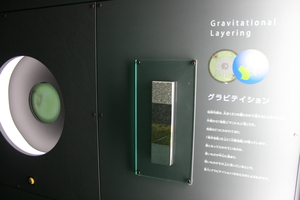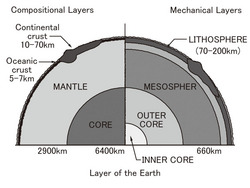Nagoya City Science Museum
TOP > Exhibition Guide > Keyword Search > Starting with "C" > core > Geosphere -Gravitational Layering-
Geosphere -Gravitational Layering-

Purpose of Exhibition
The "geosphere" is the solid part of the earth. In this exhibit, we would like to show you the phenomenon that occurs when substances are separated into light and heavy by gravitational sorting, even in the geosphere.


Additional Knowledge
【Light Substance is Up and Heavy Substance is Down】Push the button to stop stirring. Sand particles would sink in order of heaviness and layer structures are made. Light particles settle in the upper position and heavy ones settle in the lower position because of the way gravity works. It happens in the situation where sand or mud can move freely in the water. Inside of the earth also has the same structure as the sand mixed in the water, where light substances float up and heavy ones float down. That is to say, layers of the earth from top to bottom are continental crust (density 2.7g/cm3), oceanic crust (density 3.0g/cm3), mantle (density 3.3g/cm3), and core (density 11g/cm3). It indicates that each layer was differentiated from material substances of the earth. When the earth was born, it was still in a molten state. Light substances floated in the upper position and heavy ones sank in the lower position. The exhibits on display are rocks and minerals whose components are similar to each layer of continent crust, oceanic crust, mantle, and core. The geosphere consists of these substances exposed to high temperature and pressure.
【Convection Geosphere】 It is assumed that the temperature of the central part of the earth is about 6000°C. The reason why it is still a high temperature is because it has not cooled down yet. It is like a steamed meat bun. When you cut into it after it's cooked, although the surface is still cold, the inside is so burning hot that you burn yourself. The earth is similar to this. It is considered that the earth's interior is still hot, although the surface has cooled off since its formation.
Have you ever seen miso soup floating and flowing in a bowl? It is due to convection. Similarly, convection is considered to be occurring in the earth as well. It may be a little hard to understand that even though the inside of the earth is solid, except for some parts, it flows. However, if force continues to be applied to even a breakable object for a long time, it is transformed as if it is sticky liquid (=flow). A solid which is broken when it is hit can be allowed viscous flow in long time. For example, if you leave candies or caramels in a bottle for a long time, they gradually become sticky. In glacier, ice (solid water) is slowly flowing with a speed of just a few centimeters or some ten meters. Even inside of the earth, very slow convections are happening. 【Layer Structure of the Earth】In order to understand convection in the geosphere, it is better to observe in terms of how easy a substance flows (physical property) not a kind of a substance (chemical property). Classified in terms of this point of view, the geosphere consists of lithosphere, asthenosphere, mesosphere, the outer core (liquid), and the inner core (solid) in order from top to bottom. Lithosphere consists of a 100km - thick from the surface and a slipped part of the mantle which hardly ever flows (rigid body). When seen from the surface, it looks like a plate broken into several pieces and therefore it is called a "tectonic plate". Asthenosphere has relatively plastic because it is melted partly. In short, since a rigid lithosphere is placed on easily plastic asthenosphere, flat motion takes place.
Article by Shoji Nishimoto curator
